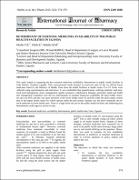| dc.contributor.author | Okello, Tom Richard | |
| dc.contributor.author | Olido, K | |
| dc.contributor.author | Mshilla, M.M | |
| dc.date.accessioned | 2021-05-23T12:40:04Z | |
| dc.date.available | 2021-05-23T12:40:04Z | |
| dc.date.issued | 2015 | |
| dc.identifier.citation | Okello, T. R., Olido, K., & Mshilla, M. M. (2015). Determinant of essential medicines availability in the public health facilities in Uganda. Int J Pharm, 5(2), 374-379. | en_US |
| dc.identifier.uri | https://hdl.handle.net/123456789/268 | |
| dc.description.abstract | This study aimed at examining the key essential medicines availability determinants in public health facilities in Gulu District, Northern Uganda. This cross-sectional study focused on stock-out rates of the six official tracer medicines listed by the Ministry of Health. Data from the health facilities at health centre II to IV levels were collected using questionnaires and interviews. It was established that quantification, ordering methods, lead-time, stock-card management, stores management, quality assurance, collaborative linkages, personnel, funds and health unit management committee were the key determinants of essential medicines availability (P-value 0.000). Stock-out rate was 85% and this was more prevalent in the lower health center IIs and IIIs under the push supply system than in the higher health center IVs which operate under the pull system. Quinine was the most commonly out-of-stock medicine in lower health units. There is a high stock-out rate in the public health facilities and addressing key determinants could improve stocks-in rates. | en_US |
| dc.language.iso | en | en_US |
| dc.subject | Essential medicines | en_US |
| dc.subject | availability determinants | en_US |
| dc.subject | public health units | en_US |
| dc.subject | Gulu | en_US |
| dc.title | Determinant of Essential Medicines Availability in The Public Health Facilities in Uganda | en_US |
| dc.type | Article | en_US |

